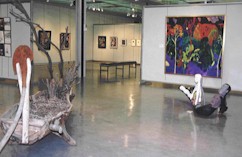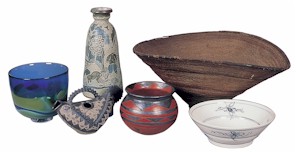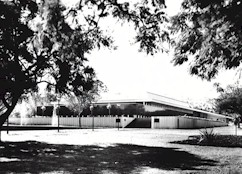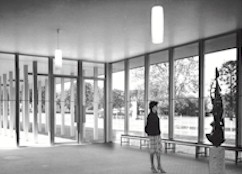The first public art collection in this country was started in 1872 with artworks meant for a South African National Gallery in Cape Town, which was authorised by Parliament in 1895. A building to house the collection only followed in 1930, almost three decades after the Durban City Hall complex was completed to provide a home for their municipal art collection. Inland, Sir Hugh Lane, art connoisseur and Director of the National Gallery in Ireland, was instrumental in assembling an art collection which was presented to the city of Johannesburg in 1910. The Johannesburg Art Gallery, the first building erected for the purpose, was opened in 1915. A number of cities followed with their own municipal collections.

The Pretoria Art Museum came into being in order to house the City Council’s growing art collection which had been built up since the early nineteen-thirties. Originally the collection was housed in the City Hall and consisted mainly of the Michaelis Bequest and a small collection of artworks by South African artists. The bequest by Lady Michaelis in 1932, after her husband Sir Max Michaelis’ death, comprised mainly paintings from the 17th century North Dutch school. Among the South African artworks there were pieces by Henk Pierneef, Pieter Wenning, Frans Oerder, Anton van Wouw and Irma Stern.
As the other South African art museums had already assembled a few fine examples of 17th, 18th and 19th century European art, it was decided to concentrate on establishing a representative collection of South African art, with emphasis on the so-called Old Masters, namely Pieter Wenning, Henk Pierneef, Frans Oerder, Anton van Wouw, Hugo Naudé, Irma Stern, Maggie Loubser and others. To represent international art, attention would be given to the acquisition of graphic printmaking from Europe and the USA, which is less expensive than oil paintings and sculpture.

In this way the contact between art from abroad and South African art would be reflected in the collection. The Museum has since been giving more attention to contemporary developments in Southern African art, including urban and rural art, as well as traditional art and new media and techniques in order to reflect the historical diversity of art in South Africa.
Contact with international art movements must be kept to be able to grasp all the stages of the development of South African art. As continually rising prices on the art market hamper the acquisition of oil paintings or sculptures by famous artists, the Pretoria Art Museum has, wherever possible, acquired graphic works by a number of famous international artists. South African art, however, remains the main focus.
The Museum
In 1954 a decision was taken by the City Council of Pretoria to have a building erected to house the art collection. Anton Hendriks, the then Curator of the Johannesburg Art Gallery, acted in an advisory capacity to the architects. In 1956 the then Town Clerk of Pretoria, Henry Preiss, who was the driving force behind the project, travelled to Europe on vacation, but also to study art museums. (The Henry Preiss Hall in the Art Museum is named after him.) The architectural firm of Burg, Lodge and Burg and W.G. McIntosh was appointed with J. Zylstra (Pty )Ltd as building contractor.

The first sod was turned in Arcadia Park on 26 January 1962. Foundation stones were laid on19 October 1962 by the then Prime Minister, Dr H.F. Verwoerd and his Worship the Mayor of Pretoria, Councillor E. Smith. The first Curator of the new Pretoria Art Museum was appointed early in 1963. The Albert Werth Hall commemorates the distinguished service of the almost three decades of Dr Albert Werth who retired as Director of the Art Museum in 1991.
At the time the building of Pretoria’s civic art museum cost R320 000, of which the Government contributed R100 000. Together with equipment and furnishings the cost was about R400 000, a sum which today cannot even buy a painting by a South African artist such as Irma Stern! Only the best materials available were used. The building is a low-slung glass and concrete edifice, incorporating modernist planning ideas with technical innovations feasible at the time. It is a fine example of the International Style in architecture. It took 18 months to complete the building, which was officially inaugurated on 20 May 1964 by the then Mayor of Pretoria, Dr P.J. van der Walt. The term museum is preferred, to distinguish it from the perception of an art gallery as a commercial venue.

Additional exhibition space was created in 1975 with the closing of the open area with colonnades between the main entrance and the East Gallery. A major upgrading of the building was undertaken in 1988 when the reflection pool on the west side was closed in. The lighting, security and air-conditioning systems were again upgraded in 1999 in preparation for the international exhibition, Leonardo da Vinci: scientist, inventor, artist. At the same time an atrium was created next to the new reference library with access from the North Gallery. An adjacent sculpture garden, visible from the atrium and from the west elevation, was designed by Cave Klapwijk & Associates CC.
Two public monuments in Arcadia Park, near the east and west wings respectively, were erected independently with the permission of the City Council and do not form part of the Museum collection. The German Government donated to South Africa the bronze relief of a mother with children, in appreciation for food parcels sent to German people during the post-war distress period. This monument was unveiled on 26 November 1964. The bronze caravel was donated to the city by a Portuguese businessman, António Braz, to commemorate the Diaz year in 1988.